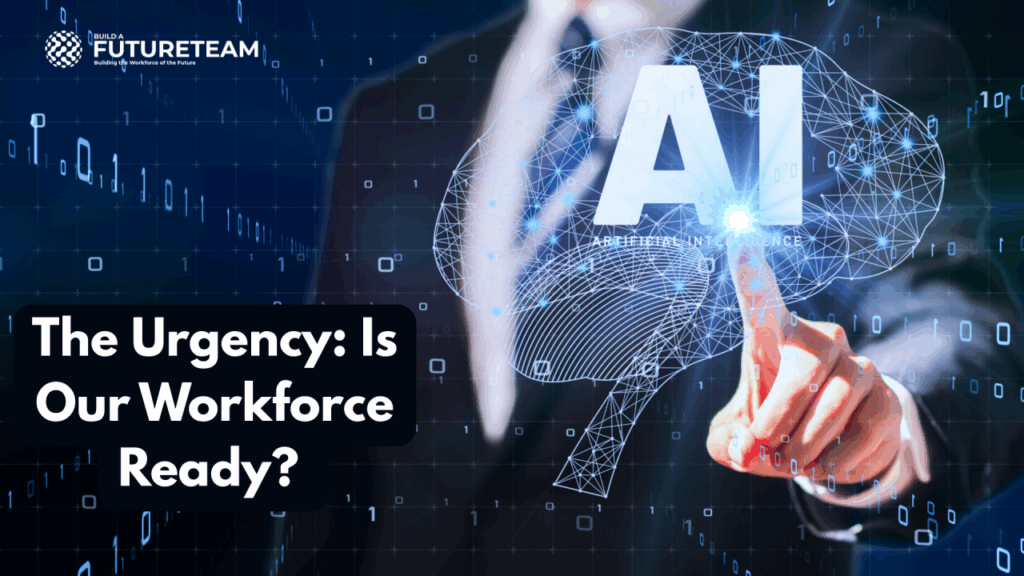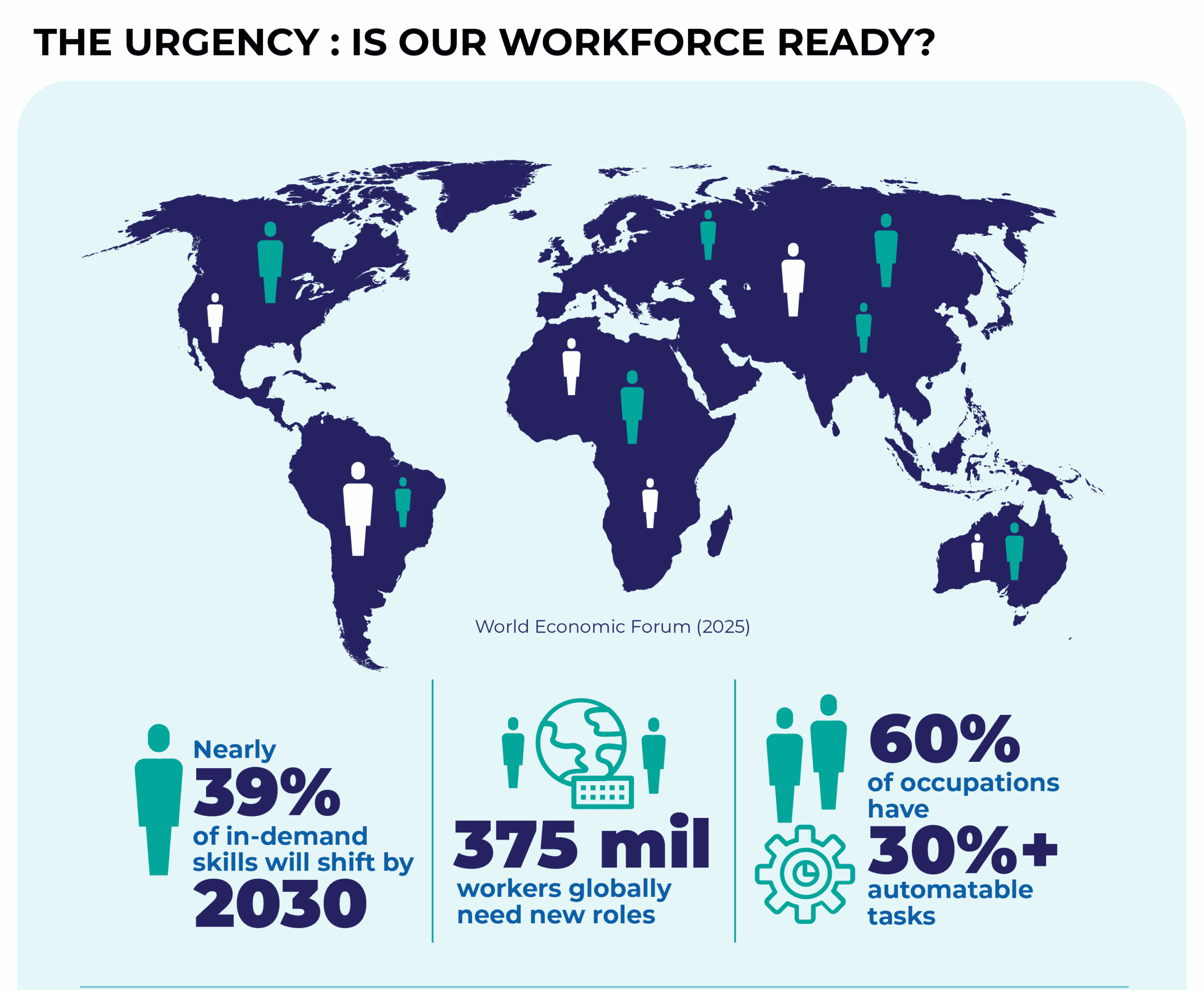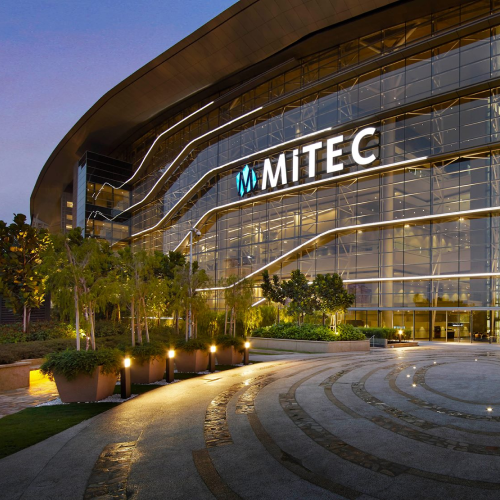
The world of work is undergoing an irreversible and inevitable transformation. The rise of Automation and Artificial Intelligence, has been integrated into many facets of work, transitioning from mere theoretical constructs to now, practical realities. From AI-powered logistics and self learning chatbots to autonomous vehicles and predictive diagnostics, these technologies are restructuring the global economy and redefining the nature of human work.
According to the World Economic Forum (2025), nearly 39% of the skills currently in demand are projected to shift by 2030, and as many as 375 million workers globally may need to transition to new roles. Meanwhile, McKinsey as well reveals that 60% of current occupations have at least 30% of their tasks automatable. We aren’t anticipating the arrival of disruption, it already is here, moving faster than most businesses are prepared. So the question is, is our workforce ready?
This transformation demands far more than just upgrading software, or sending employees for technical training. It requires a full-scale redefinition of what preparedness looks like in the modern organisation. Relevance today hinges not just on digital fluency, but also on human adaptability, systems-level thinking, and leadership at every level. Navigating this disruption means confronting uncomfortable truths: job roles are evolving faster than job titles, and culture – not just competence, will determine whether companies thrive or fall short.

The infographics above reveals what we can expect for the future of work
Automation is not replacing work – it’s redefining how it is done. Rather than wholesale job elimination, the real impact is in task reconfiguration, and skill displacement. Entire new roles are emerging, more jobs are created than lost, paving a way for the unfolding of a new era in the labour market.
This shift is evident in the stark decline of demand formula, routine, and basic cognitive tasks. McKinsey’s analysis reveals that occupations in physical and manual work are expected to decline by 11% in the U.S. and 16% in Europe by 2030. Moreover, basic clerical roles – think data entry and routine inspections, are facing a projected drop of 19-23% over the same period. These aren’t small numbers; they represent millions of roles being systematically automated – making today’s workforce landscape fundamentally different from the past.
At the same time, demand for higher order skills is surging. A steady growth for analytical and creative capabilities globally, coupled with a rise in social and emotional competencies shows opportunities for us humans to take a step forward and a step up in contributing in ways we do best: Intellectual and emotional capabilities that machines still lack.
While Artificial Intelligence can gather data and configure optimal processes, it is up to humans to take action, through AI literacy and data-visualisation, to capitalise on the efficiencies automation offers. Research published in IESE USA found that as automation advances, demand for managerial and interpersonal roles have also grown–companies deploying AI actually increased management vacancies by 2.5%-7.5%, as leaders are needed to guide AI adoption.

The infographic above reveals shifting job skills in the age of AI
Even roles traditionally seen as safe havens are transforming too. Administrative positions, for instance, are evolving to include responsibilities like managing cloud-based collaboration platforms, interfacing with automated scheduling systems, and orchestrating digital processes. McKinsey forecasts that 8-9% of future labour demand will emerge in entirely new occupations – an indicator that nearly every role ripe for automation is being redefined around human-technology collaboration.
This tectonic shift in the labour market is anything but a slow-moving wave, it is a fast paced tsunami poised to flush out organisations that assume stability. With routine jobs disappearing and technical tasks being prone to an AI takeover, the pressure is on for companies to invest in upskilling and cultural transformation. Leaders face a clear choice: wait, and risk systemic obsolescence, or take decisive action – creating adaptive learning cultures, embedding digital fluency across teams, and recognising human potential as the anchor of tomorrow’s business strategies.
The effect of automation is here to impact the norms of daily operations and workforce strategies. The real question isn’t what automation will do to our business – but whether our workforce can move fast enough to meet it. Is your organisation positioned to pivot with purpose? Time is running out, and readiness is the only path forward.
Author name: Justin Lee
Build a Future Team aggregates a legion of business, impact, and skill partners to establish a new benchmark for social impact in the digital era across Southeast Asia. We are poised to impact 10 million lives through digital workforce transformation.

Lorem ipsum dolor sit amet, consectetur adipiscing elit. Ut elit tellus, luctus nec ullamcorper mattis, pulvinar dapibus leo.

Lorem ipsum dolor sit amet, consectetur adipiscing elit. Ut elit tellus, luctus nec ullamcorper mattis, pulvinar dapibus leo.

Lorem ipsum dolor sit amet, consectetur adipiscing elit. Ut elit tellus, luctus nec ullamcorper mattis, pulvinar dapibus leo.

Lorem ipsum dolor sit amet, consectetur adipiscing elit. Ut elit tellus, luctus nec ullamcorper mattis, pulvinar dapibus leo.

Lorem ipsum dolor sit amet, consectetur adipiscing elit. Ut elit tellus, luctus nec ullamcorper mattis, pulvinar dapibus leo.

Lorem ipsum dolor sit amet, consectetur adipiscing elit. Ut elit tellus, luctus nec ullamcorper mattis, pulvinar dapibus leo.

Lorem ipsum dolor sit amet, consectetur adipiscing elit. Ut elit tellus, luctus nec ullamcorper mattis, pulvinar dapibus leo.

Kompleks MITEC KL Metropolis,
8, Jalan Dutamas 2,
Segambut, 50480 Kuala Lumpur,
Wilayah Persekutuan Kuala Lumpur